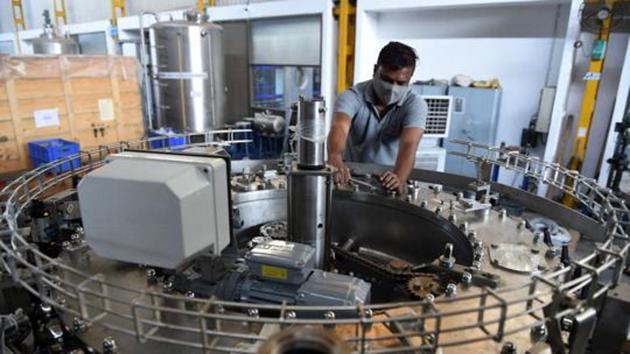Decoding the nature of economic recovery
At the same time, there are other statistics that suggest a more sober approach. Here are four charts put these mutually conflicting trends in context.
According to the first advanced estimate by National Statistical Office (NSO), the Indian economy is expected to contract by 7.7% in fiscal 2020-21 – 20 basis points more than the 7.5% contraction projected by the Monetary Policy Committee (MPC) of the Reserve Bank of India.

High frequency indicators suggest greater optimism than the MPC’s forecast of 0.1% growth in the December quarter. At the same time, there are other statistics that suggest a more sober approach. Here are four charts put these mutually conflicting trends in context.
NIBRI, PMI, GST collections suggest a robust ongoing recovery
The two earliest high-frequency economic indicators – Purchasing Managers’ Index (PMI) for manufacturing and the Nomura India Business Resumption Index (NIBRI) – for the period ending Dec 2020 were released on Jan 4. Both of them suggest an upbeat economic environment. For the week ending January 3, NIBRI reached its highest ever value of 94.5 (100 is the pre-lockdown base). PMI manufacturing was at 56.4 in Dec 2020, making it the fifth consecutive month when it was above the critical threshold of 50, which signifies an expansion in economic activity compared to previous month. PMI Services, while it was above the threshold of 50 for the third consecutive month in Dec, has been losing momentum since Oct. Goods and Services Tax (GST) collections in Dec – they are supposed to capture transactions carried out in Nov – reached ?1.15 lakh crore, the highest ever nominal monthly collection. In an interview to HT, finance secretary Ajay Bhushan Pandey attributed the increase in December GST collections to “greater economic activities and better compliance with targeted approach to curb evasion”.
However, both NIBRI and PMI note continuing job losses
Many economists have pointed out that the ongoing economic recovery is being led by profits and therefore has a smaller base. The latest NIBRI and PMI releases underline this trend. “Employment decreased in December, thereby stretching the current sequence of job shedding to nine months. Companies stated that government guidelines to have employees working only on shifts and difficulties in finding suitable staff were the key factors causing the latest fall in payroll numbers,” said a statement from IHS Markit, the agency which releases the PMI numbers. To be sure, “the pace of (employment) contraction was moderate and the weakest in the current downturn period”, the statement added. A research note by Nomura economists also noted a worsening on the employment front. “The labour participation rate eased to 40.3% in early January from 40.9% in December”, it said. These observations are in sync with the unemployment trends from the Centre for Monitoring Indian Economy (CMIE) database, the only high-frequency source of employment statistics in India.
“Employment has been falling month-after-month since September 2020 when it was estimated at 397.6 million. As a result, employment has not only remained consistently below year-ago levels, it has also fallen far short of the two-years ago levels. Employment in November and December 2020 was lower than it was in November and December 2019 and was also lower than it was in November and December 2018, respectively” Mahesh Vyas, CMIE’s managing director and chief executive officer, said in a note published on its website.
October-November revenues have increased for the Centre, but states have not gained
Data from the Controller General of Accounts, which works under the ministry of finance, shows that gross tax revenues on October and November (latest available data) were greater than last year’s levels. To be sure, overall Gross Tax Revenue (GTR) up to November for fiscal year 2020-21 was still lower than 2019-20 levels. Even the monthly improvement seen in October-November GTR collections is driven by higher union excise duty collections, which are on account of increased taxes on petrol and diesel. Because the additional taxes on petrol and diesel and not a part of divisible pool of taxes, states have not seen an improvement in tax devolutions from the centre. In fact, year on year shortfall, both on a monthly and cumulative basis, in centre’s tax devolution to the states has been the highest in October and November in the current fiscal year.
The Centre-state asymmetry in tax collections has also translated into spending
Central taxes were meant to provide for 31% of states’ total receipts in the current fiscal year. As this shortfall increases, state finances are bound to come under greater strain, especially given the fact that state governments have done most of the heavy lifting in dealing with the pandemic. CMIE had cumulative spending data for 13 states up to November 2020. A comparison with cumulative spending for these states up to November 2019 shows a 6.5% reduction. For the 19 states for which cumulative spending figures are available up to Oct 2020, there was a 4.8% shortfall compared to Oct 2019 levels. The shortfall in capital expenditure for these states was even greater: 28.3% on an annual basis up to Oct 2020 and 27.9% up to Nov 2020. States incur a bigger spending than the Centre in India, especially when it comes to capital expenditure, which is crucial for future growth. Budget estimates for 2020-21 put the Centre’s total spending and capital spending at 72.2% and 46.6% of the total spending by states on these heads. Given the shortfall in states’ spending and their precarious revenue situation, the fiscal year is likely to end with a pro-cyclical cut in government spending.
Get Current Updates on India News, Ram Navami Live Updates , Lok Sabha Election 2024 live, Elections 2024, Election 2024 Date along with Latest News and Top Headlines from India and around the world.




